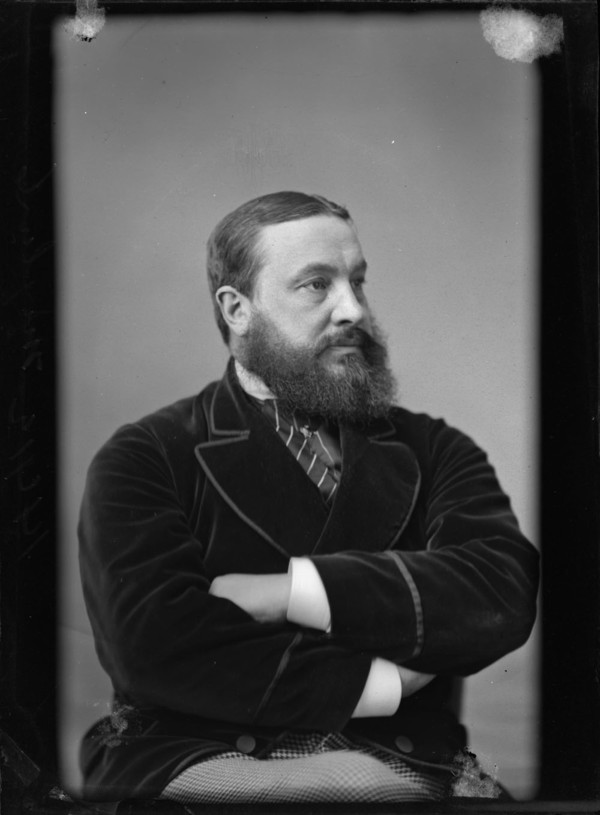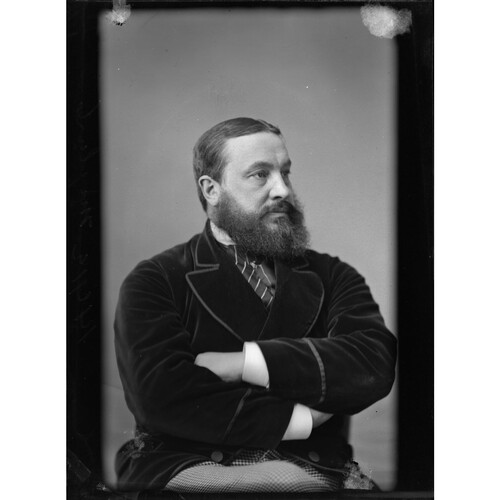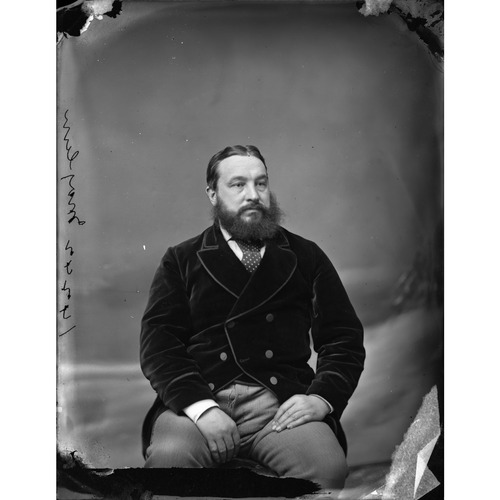MOYLAN, JAMES GEORGE, teacher, editor, publisher, and civil servant; b. 11 Jan. 1826 in Maynooth (Republic of Ireland), son of Michael Moylan and Mary Bird; m. Elizabeth Markham of County Clare (Republic of Ireland), and they had two daughters; d. 18 Jan. 1902 in Ottawa.
James George Moylan was educated at St Jarlath’s College, Tuam, in County Galway, and in 1842–47 at the Royal College of St Patrick, Maynooth. In 1848 he entered the British customs service in London. He resigned three years later and went to the United States, where he was attached to the Chilean delegation in Washington. At that point he began a distinguished career in journalism. From about 1852 to 1854 he was the Washington correspondent for the New York Daily Times and wrote for several other papers; in 1854–56 he was a member of the Times staff. He came to Upper Canada in 1856 as professor of classics and English literature in the Jesuit college at Guelph, a position he held until 1858.
In that year he and James J. Mallon bought out the Catholic Citizen of Toronto and continued it there as the Canadian Freeman. Moylan was editor and, from 1859, sole proprietor. Under his trenchant and partisan pen, the paper attracted a wide constituency in Upper Canada as the defender of Irish Catholic causes (the Irish made up the greater part of the province’s Catholics). Often it reflected the views of Thomas D’Arcy McGee*, a leading Catholic spokesman in politics. Always close to the hierarchy, and especially to Bishop John Joseph Lynch*, who frequently received editorial space, the journal opened a door to the values and opinions of the Irish Catholic community. In contrast to the growing Sabbatarianism of many Protestant journals, the Freeman in 1862 supported Sunday street-railway service in Toronto as a means of facilitating leisure activity for the working class. The paper consistently backed legislation to extend the rights of separate schools; it regarded the Separate School Bill, introduced in 1860 by Richard William Scott*, as an improvement but by no means the final solution. It was over the schools issue, in fact, that Moylan, to McGee’s initial chagrin, broke with George Brown* and the Reformers in 1860, when it became clear that Protestant Reformers would not support Catholic institutions. The Freeman strongly favoured the union of the Canadas as the best protection for minority religious rights and was critical of the political program of John Sandfield Macdonald*, provincial co-premier in 1862–64, whose Scottish brand of Catholicism and whose support for the principle of the double majority as a solution to constitutional difficulties were not to its liking. The paper reserved its most vitriolic editorials for the Clear Grit branch of the Reformers, which it often described as republican, and for George Brown, who was regularly denounced for his bigotry.
After his break of 1860 Moylan became a consistent supporter of John A. Macdonald*’s variety of Conservatism, both for its tolerant approach to religious and ethnic relationships and for its constructive role in economic development and national expansion. The Freeman remained unenthusiastic about confederation, however, even after it had been taken up by Macdonald in 1864, Moylan maintaining with other Conservatives that it involved the “surrender of U. Canada to the Grits.”
The most useful insights to be gained from the Freeman derive from its position on the Irish Catholic role in Canadian life. Although strongly sympathetic to Irish causes, it proclaimed in August 1863 that “Canada is not the battleground whereon the wrongs and grievances of Ireland are to be avenged.” Thus the paper supported causes which it deemed to be in the Canadian interest and did so in the belief that there was a significant place for Irish and Catholic values within that interest. The journal even worried in November 1863 that the Reciprocity Treaty with the United States would damage incipient Canadian manufactures and would alienate Britain from Canada. Most of all, it was outraged in 1866 by the incursions of the Fenians [see Michael Murphy*; John O’Neill*], whom it denounced as rowdies more American than Irish in outlook. Similarly, the Freeman’s views led it to oppose exclusive Irish Catholic organizations if they were not religious in their foundation.
Moylan’s career sheds some light on the workings of the political patronage system. During the first federal election campaign, in 1867, he wrote a highly effective pamphlet aimed at the Irish Catholics of Ontario. Macdonald, who became prime minister, was appropriately grateful. In 1871 he assured a member of the Catholic hierarchy that he had always appreciated Moylan’s loyalty. “While he was conducting his paper, I did everything I possibly could, and not infrequently went further than in strict law I ought to have done getting him the sinews of war to support the ‘Freeman.’” However, after confederation, he explained, changes in the law had made it difficult for governments to support a partisan press, and the Freeman had suffered as a result. In these circumstances, Macdonald seemed anxious to find a post to offer his old friend and supporter. In 1869, as the Freeman showed signs of failing, Moylan had wanted to succeed the retiring warden of Kingston Penitentiary, Donald Aeneas MacDonell*, but the post went to John Creighton*. It was perhaps as a consolation prize that Moylan was appointed later in 1869 as an emigration agent for the government of Canada in Ireland. The nature of his continuing association with the Freeman while he was there is unclear, but it did not discontinue publication until 1873, at which point Moylan was back in Canada and in a more significant patronage position.
In 1872 Macdonald, who was also minister of justice, had appointed Moylan to the Board of Directors of Penitentiaries; the following year Moylan became its secretary director. This three-man board, with responsibility for Kingston Penitentiary and smaller prisons in Saint John and Halifax, had duties which were far narrower than the pre-confederation board of inspectors [see Edmund Allen Meredith*]. A further narrowing of power and function occurred in 1875, during the Liberal administration of Alexander Mackenzie*, when an act was passed that replaced the board with a single inspector of penitentiaries. This position went to Moylan, and he would serve efficiently and creditably until his retirement in 1895. His 1872 appointment doubtless owed much to his friendship with Macdonald, yet he must have earned respect or he would not have received such a vote of confidence in 1875 from the Liberal government. For the next two decades his was the most powerful voice in Canada in penitentiary reform and administration.
Moylan’s achievements were severely circumscribed by penitentiary legislation, distance, and the general indifference of Canadian politicians and the public to penitentiary conditions. The 1875 statute not only replaced the directors with an inspector, but brought that official firmly under the authority of the minister of justice. As the power of the minister increased, that of the inspector and of individual wardens waned. The new emphasis on centralization and bureaucratization was a necessary corollary of the requirements of a penal system that was rapidly expanding across a vast continental nation. In his early years in prison administration Moylan was deeply involved in the planning and opening of new penitentiaries: St Vincent de Paul in Quebec (1873), Stony Mountain in Manitoba (1877), British Columbia Penitentiary at New Westminster (1878), and Dorchester in New Brunswick (1880). After 1875 major staff appointments were made by the minister, the wardens required authorization for even minor expenditures, and all policy initiatives proceeded from the minister through the inspector. None the less the influence of the department’s bureaucracy was limited by such practical considerations as the first-hand administrative experience of local officers and the distances that separated the penitentiaries from Ottawa. At one point, the warden in New Westminster complained that it had been seven years since Moylan had inspected his facility. And Moylan’s staff remained small: he received a full-time clerk in 1876, and in 1888 his operation was composed of “two officers, an accountant and a third class clerk.” His own authority had been further limited in 1879 when an accountant of penitentiaries was appointed as the departmental watchdog.
The narrowly defined nature of Moylan’s position was driven home when various ministers of justice persistently ignored recommendations for change that were clearly inexpensive and commonsensical. In his annual reports Moylan lamented the government’s failure to send a representative to international penal congresses or even to follow the example of the province of Ontario, which sent its officers to observe American penitentiaries. His recommendations that regular meetings of the wardens be held and that a system of staff training be instituted were also disregarded. Nor did the department act on his concern for female convicts and his suggestion that a separate women’s prison be constructed. On several occasions he was blunt about the shortcomings of prison guards and the damage they were doing to efforts to achieve rehabilitation, but even the expression of these views in his reports failed to move the government or parliament. In these circumstances, few significant reforms were achieved in Canadian penitentiary administration in the last quarter of the 19th century.
A promising beginning had been made in the 1860s when the distinguished inspector E. A. Meredith, condemning the so-called Auburn system used at Kingston Penitentiary as unrelentingly punitive in its approach, worked to bring in components of the famous system of reformatory prison discipline established by Irish prison reformer Sir Walter Crofton, whereby convicts could progress to a gradual reintroduction to society by ticket of leave. The Penitentiary Act of 1868, which Meredith authored, introduced such Croftonian elements as earned remission and payment to convicts for extra-stint production. Moylan gave full consideration to a more complete introduction of the Crofton system in Canada. During his administration, however, the spirit and much of the letter of reformatory prison discipline were rejected.
Work had started on a Croftonian-type prison of isolation in 1870 within Kingston Penitentiary but was suspended the following year. When completed in the 1890s the prison was used for punishment and to house the least desirable convicts, with the original idea of an initial penal phase lost to view. The payment of bonuses to productive convicts had ended years earlier, and earned remission was about all that remained of earlier Croftonian ideals. Although Moylan regretted this decline, he had concluded realistically that Canadian conditions would never permit the full Irish program. In 1877 he pointed out that the country could not bear the cost of building separate institutions to house convicts during different phases of imprisonment or of providing the close supervision of inmates that would be required on prison farms or during their release on tickets of leave. But having rejected the full Crofton system, Moylan continued to insist that reformation must be the leading objective of prison policy. To that end he argued that the Irish system was too rigorous for Canadian convicts, who responded better to kind treatment and inducements. Moylan believed that prisoners in Canada were treated more charitably than in many other jurisdictions. Convicts, he explained in 1883, “are all men having one common human nature” and in prison “must be treated upon the universal principles of human nature and by methods as nearly possible assimilated to those methods of education, influence and restoration, which are used towards those who are out of prison.” The very fact of imprisonment, he insisted, was punishment enough, and while confined the convict should be regarded as “the ward of the state, whose duty it is to treat him humanely.”
Regrettably, it proved difficult to translate such humanitarianism into practical programs. Moylan was able to effect a few improvements, including an increase in size of Kingston’s notoriously small cells – a step supported by one reform-minded justice minister, Sir John Sparrow David Thompson* – and a move away from corporal punishment. But with Croftonian principles regarded as inappropriate, Moylan could do little more than try to administer the Auburn system as humanely and efficiently as possible. And in that respect he was supported by a number of capable wardens, among them Samuel Lawrence Bedson* at Stony Mountain. Inevitably, however, convict labour continued to dominate the life of the penitentiaries. As an administrator of progressive views, Moylan opposed purely penal labour and he abhorred the system of letting out convict labour, which was phased out following legislation in 1883. After 1886 the bulk of prison labour was done for the public account. Moylan believed that such semi-skilled activity as quarrying, brick making, and farming habituated convicts to the constructive value of work and trained them for occupations compatible with their station in life. Few advances were made in this period in either education or religious programs. Not surprisingly, given the power of the late-19th-century evangelical revival, Moylan believed that religion should play a vital role in convict reformation, but he was unable even to have all penitentiaries supplied with full-time chaplains. In this connection it is significant that he was a great admirer of the Toronto-based Prisoners’ Aid Association, a volunteer organization led by some of the most prominent members of the evangelical churches, among them William Holmes Howland*. The PAA, however, remained provincial in its orientation, and little work was done with discharged prisoners at the national level.
Like many prison administrators of his era. Moylan became concerned with the problem of recidivism. As early as 1876 he recommended that the law be changed to deny remission and other privileges to repeat offenders. From 1885 on he advocated dealing with recidivism by means of the indeterminate sentence, a policy which had much support in the United States. He argued that “to treat all criminals in the same manner is as absurd as would be the proposition to cure all the diseases of the body . . . by the same medical agents.” In contrast, Sir John Thompson maintained that indeterminate sentences put inmates at the mercy of their jailers.
The efforts of Moylan and other reformers to elevate penology to a science which focused on the criminal rather than on the crime was part of a progressive movement that led in 1899 to Canada’s first national parole legislation, the initiative for which had been supported by Thompson during Moylan’s tenure. And Moylan, like most other Canadians who worked with convicts or campaigned for reform, was extremely cautious about the theories of hereditary causation advanced by the followers of Italian criminologist Cesare Lombroso. Moylan held to the older view that most crime had environmental causes and could be dealt with in a correctional setting. To his mind, society must share responsibility with the criminal, and he was scathing in his criticism of a community that offered little solace or practical assistance to the released offender.
Having retired in January 1895 on a government pension, J. G. Moylan died of heart failure at his home on Daly Avenue, in Ottawa, on 18 Jan. 1902. He had faced many disappointments during his long career in prison administration. Altogether the lot of the convict remained unrelentingly hard, and the system’s emphasis on centralization and bureaucratized decision-making was laying a solid foundation for horrible conditions in Canadian prisons. As an honest administrator and a humane man alert to new movements in penology, Moylan may have been able to make conditions a little more bearable for many prisoners. But perhaps the final significance of his career is that it demonstrates yet again the inability of one individual, no matter how strategically placed, to make much difference in a system founded on solid pillars of parsimony, prejudice, and apathy.
AO, RG 22, ser.354, no.3914. NA, MG 29, D15. Canadian Freeman (Toronto), 1858–73. Ottawa Evening Journal, 20 Jan. 1902. W. A. Calder, “The federal penitentiary system of Canada, 1867–1899: a social and institutional history”
Revisions based on:
J. A. Claffey, “Irish historic towns atlas, no.20,” Tuam (intro.): www.ria.ie/research-projects/irish-historic-towns-atlas (consulted 15 Oct. 2018).
Cite This Article
Peter Oliver, “MOYLAN, JAMES GEORGE,” in Dictionary of Canadian Biography, vol. 13, University of Toronto/Université Laval, 2003–, accessed December 28, 2025, https://www.biographi.ca/en/bio/moylan_james_george_13E.html.
The citation above shows the format for footnotes and endnotes according to the Chicago manual of style (16th edition). Information to be used in other citation formats:
| Permalink: | https://www.biographi.ca/en/bio/moylan_james_george_13E.html |
| Author of Article: | Peter Oliver |
| Title of Article: | MOYLAN, JAMES GEORGE |
| Publication Name: | Dictionary of Canadian Biography, vol. 13 |
| Publisher: | University of Toronto/Université Laval |
| Year of publication: | 1994 |
| Year of revision: | 2019 |
| Access Date: | December 28, 2025 |





